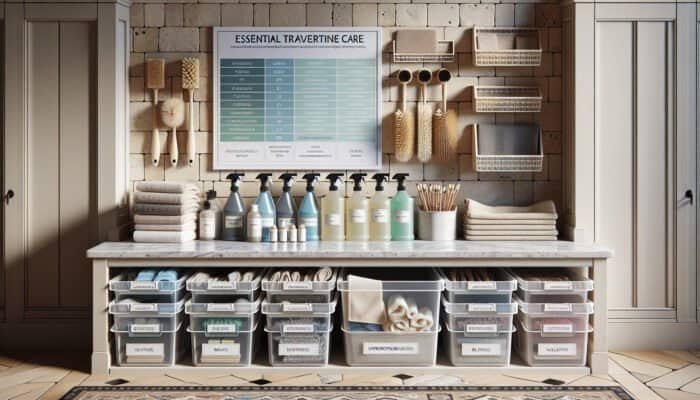Explore the Exceptional Beauty and Benefits of Travertine for Homes Throughout the UK
Travertine has emerged as one of the most desirable materials for homeowners in the UK, and the reasons behind this growing trend are indeed impressive. Its remarkable aesthetic attributes, paired with numerous practical advantages, position it as a superior choice for flooring, walls, and even outdoor patios. As a member of the limestone family, travertine showcases a unique texture and an extensive colour palette, enabling it to effortlessly blend into a variety of design styles. In this detailed exploration, we will delve into the most favoured types of travertine that resonate with UK homeowners, assess the primary factors driving its popularity, and address the specific challenges it must overcome due to the UK's unpredictable climate.
Exploring the Most Popular Varieties of Travertine Preferred by UK Homeowners

Across the UK, a variety of travertine types have found favour among homeowners for both residential and commercial uses. The most commonly preferred varieties include classic beige, ivory, and walnut travertine, predominantly extracted from esteemed quarries located in Italy and Turkey. The classic beige variety is celebrated for its warm tones, which impart a sense of timeless elegance to interiors, making it an ideal selection for traditional British homes. On the other hand, ivory travertine, known for its lighter shades, fosters an open and airy atmosphere, making it particularly advantageous for compact spaces or contemporary designs.
Walnut travertine, characterised by its deep, rich hues, serves as an eye-catching focal point in larger areas, offering a dramatic contrast that enhances visual depth. Each travertine variety presents unique characteristics, including a range of patterns and textures, which contribute to the visual interest of any room. Understanding these distinct varieties not only assists homeowners in making informed choices but also deepens their appreciation for the inherent beauty of travertine tiles, recognising them as essential elements in the interior design of UK residences.
Identifying the Key Factors Driving the Popularity of Travertine in British Homes
The captivating allure of travertine in British homes stems from its extraordinary blend of visual appeal and functional characteristics. Aesthetically, its natural stone composition brings warmth and sophistication to any environment. The versatility of travertine in complementing a broad spectrum of design styles, ranging from rustic to modern, ensures its ongoing relevance in various settings. Beyond its striking appearance, the practical benefits it offers further enhance its appeal; travertine is incredibly durable, able to endure the demands of everyday use, making it particularly suitable for high-traffic areas.
In addition, travertine possesses natural insulation properties that aid in regulating temperature throughout the year, which is especially beneficial given the UK's fluctuating weather conditions. Incorporating travertine into a property can also elevate its resale value, as its timeless charm is often appealing to prospective buyers. An increasing number of homeowners in the UK are seeking materials that seamlessly merge style with durability, and travertine excels in fulfilling both of these fundamental requirements.
Addressing the Unique Challenges Faced by Travertine in the British Climate
While travertine undeniably showcases beauty and resilience, it does encounter specific challenges, particularly regarding the UK's unpredictable weather conditions. Frequent rainfall and dampness can lead to complications such as efflorescence, a condition where white mineral deposits emerge on the tiles' surface. This occurs when moisture evaporates from the stone, leaving behind salts that crystallise, potentially detracting from the overall aesthetic appeal of the tiles.
Moreover, freezing temperatures present significant risks, as water trapped within the porous structure of the travertine can expand when frozen, leading to cracks over time. To mitigate these challenges, it is essential for homeowners to adopt a proactive maintenance regimen. Regular sealing, coupled with careful cleaning techniques, can significantly diminish the adverse effects of moisture, ensuring that travertine retains its natural beauty despite the often damp conditions characteristic of the UK. Understanding these unique challenges is crucial for any homeowner dedicated to effectively maintaining their travertine tiles.
Essential Cleaning Supplies for Maintaining Travertine in UK Homes

To keep your travertine tiles in pristine condition, it is crucial to use appropriate cleaning supplies that are specifically designed to meet the unique requirements of this exquisite material. Being a natural stone, travertine demands careful handling to prevent damage during the cleaning process. This segment will outline recommended cleaning agents, essential tools, where to source these supplies in the UK, and tips for safe storage, ensuring your cleaning routine is both effective and efficient.
Top Recommended Cleaning Products for the Care of Travertine Tiles
Selecting the right cleaning products is vital for preserving the beauty and integrity of your travertine tiles. In the UK, numerous brands offer specialised cleaners that are formulated specifically for natural stone. A highly recommended option is a pH-neutral stone cleaner, which effectively removes dirt and grime without harming the surface of the tiles. Brands such as Lithofin and Stonecare provide excellent solutions tailored specifically for travertine maintenance.
It is imperative to avoid using acidic or abrasive cleaners, as these can erode the surface and dull the stone's natural shine. A simple mixture of warm water combined with a few drops of mild dish soap can serve as an effective homemade cleaning solution. For more stubborn stains, consider employing a poultice made from baking soda and water, which can gently lift the stain without damaging the stone. Understanding the appropriate products to utilise will ensure that your travertine tiles remain sparkling clean and free from harm.
Essential Tools for Effectively Cleaning Travertine Tiles
Equipping yourself with the right tools is essential for the proper upkeep of travertine tiles. A soft-bristle broom or a dust mop is perfect for daily dusting, as it helps prevent scratches on the surface. For more thorough cleaning tasks, a microfiber mop is highly recommended, as it effectively attracts dirt and grime without the need for harsh chemicals.
Investing in a high-quality soft cloth for drying and buffing the tiles after cleaning is also a wise decision. Additionally, a bucket, sponge, and a gentle scrub brush are invaluable for more extensive cleaning efforts. By ensuring that these essential tools are readily accessible, you can establish a streamlined cleaning routine that not only protects your travertine but also enhances its visual appeal throughout your home.
Where to Source Cleaning Supplies for Travertine in the UK

Acquiring suitable cleaning products for your travertine tiles has become increasingly straightforward, thanks to the wide variety of options available throughout the UK. Local hardware stores such as B&Q and Wickes stock an array of stone-specific cleaning products. Furthermore, specialised retailers like The Stone Care Shop offer high-quality cleaning solutions tailored specifically for travertine.
The convenience of online shopping has further simplified the process of obtaining these essential supplies. Websites like Amazon and eBay frequently feature an extensive selection of products, complete with customer feedback that can assist in guiding your purchasing decisions. For tools, consider visiting home improvement stores or local cleaning supply shops. Ensuring easy access to appropriate products is crucial for effectively maintaining the integrity of your travertine tiles.
Best Practices for Safely Storing Cleaning Supplies
Proper storage of cleaning supplies is essential for maintaining their quality and ensuring safety within your home. First and foremost, keep cleaning agents in a cool, dry environment away from direct sunlight or heat sources, as these can diminish their effectiveness over time. Utilising clearly labelled containers will facilitate easy identification, particularly for homemade solutions.
If you have children or pets, consider storing these supplies in a locked cabinet or on a high shelf to prevent accidental ingestion or exposure. Additionally, always ensure that all caps are tightly secured to avoid spills. Implementing these precautions will help preserve your cleaning supplies while enhancing safety in your home environment.
Thorough Cleaning Procedures for Travertine Tiles in UK Homes
Cleaning travertine tiles requires a systematic approach to ensure they remain in exceptional condition. This section provides a comprehensive step-by-step guide that homeowners throughout the UK can follow, covering daily maintenance practices, methods for deep cleaning stubborn stains, seasonal care tips, the significance of sealing travertine, and techniques for repairing and restoring damaged tiles.
Establishing a Consistent Daily Maintenance Routine for Travertine Tiles
To guarantee your travertine tiles retain their utmost beauty, establishing a daily maintenance routine is essential. Begin each day by sweeping away dust and debris using a soft-bristle broom or a dust mop. This straightforward action helps to prevent dirt accumulation, which could potentially scratch the surface of your tiles over time.
For flooring, employing a damp mop with a pH-neutral stone cleaner provides a gentle yet effective cleaning option. It is critical to exercise caution to avoid saturating the tiles, as excessive moisture can lead to issues such as efflorescence or mildew. By adhering to this routine, you not only keep your travertine clean but also help preserve its natural luster, ensuring it remains a stunning feature in your home for years to come.
Effective Techniques for Deep Cleaning Stubborn Stains on Travertine
Despite regular maintenance, stubborn stains may occasionally mar the appearance of your travertine tiles. For effective deep cleaning, start by identifying the type of stain present. For organic stains, such as those from food or beverages, a mixture of baking soda and water applied as a poultice can be particularly effective; allow it to sit for several hours before gently scrubbing and rinsing the area.
For oil-based stains, mineral spirits may assist in lifting the stain, but always conduct a test on a small, inconspicuous area first. When tackling soap scum or mineral deposits, a vinegar and water solution can be effective; however, it should be used sparingly, as vinegar can erode the stone over time. By employing these deep cleaning techniques, you can ensure that your travertine tiles remain resilient against stains, preserving their beauty and overall aesthetic appeal.
Seasonal Maintenance Tips for Travertine in the UK
The changing seasons in the UK can significantly influence the care requirements for travertine tiles. During the winter months, increased moisture levels and potential freezing conditions can pose challenges, such as cracking. To combat these issues, consider sealing your tiles before winter to establish a protective barrier against moisture infiltration.
In spring and summer, outdoor travertine surfaces like patios may require more frequent cleaning due to environmental debris and pollen. Regular sweeping and rinsing of these areas will help maintain their appearance. In autumn, it is essential to promptly clear fallen leaves to prevent staining and moisture retention. By adapting your care routine to align with the seasons, you can prolong the life and beauty of your travertine surfaces.
The Importance of Sealing Travertine for Long-Lasting Protection
Sealing travertine is a critical step in safeguarding its integrity and enhancing its natural beauty. A high-quality sealer creates a protective shield that guards against stains and moisture, ensuring that the tiles remain in excellent condition over time. In the UK, it is advisable to seal travertine surfaces every 6 to 12 months, depending on usage and exposure to the elements.
Before applying a sealer, ensure that the tiles are thoroughly clean and completely dry. Use a paint roller or a sprayer to evenly distribute the sealer across the surface, allowing it to penetrate the stone effectively. After a brief waiting period, wipe away any excess with a soft cloth. Regular sealing not only protects your travertine tiles but also enhances their natural colours, ensuring they maintain their stunning visual appeal for many years to come.
Effectively Repairing and Restoring Your Travertine Tiles
Over time, chips and cracks may develop in travertine tiles; however, with the correct approach, these imperfections can be repaired, restoring their elegance. For small chips, a stone repair kit can be utilised, typically containing epoxy resin that matches the travertine’s colour. Begin by cleaning the affected area, applying the epoxy, and smoothing it out to blend seamlessly with the surrounding surface.
For larger cracks, it may be necessary to consult a professional to ensure a flawless repair. Regular maintenance can prevent significant damage over time. By closely monitoring signs of wear and promptly addressing any issues, you can maintain the value and beauty of your travertine tiles, allowing them to remain a cherished feature in your home for many years to come.
Strategic Approaches to Prevent Damage to Travertine in the UK
While travertine is renowned for its beauty and durability, it is not immune to damage, especially in the UK’s unpredictable climate. This section outlines strategies to protect travertine from rain and moisture, highlights common mistakes homeowners make in travertine care, and emphasises the critical need for regular sealing to extend the lifespan of your tiles.
Protecting Your Travertine from Rain and Moisture in the UK
Given the UK’s notorious reputation for rain, it is essential to safeguard your travertine tiles from excess moisture. Installing appropriate drainage systems around outdoor travertine surfaces can assist in directing water away from the tiles, thereby significantly reducing the risk of damage. Furthermore, employing a quality sealant creates a barrier that helps prevent moisture from penetrating the stone.
For indoor travertine, consider placing mats in entryways to absorb moisture from footwear, and avoid wet mopping, which can lead to water pooling. Promptly addressing spills and puddles is also crucial in mitigating potential damage. By implementing these preventative measures, you can effectively safeguard your travertine from the adverse effects of the UK’s wet weather, ensuring its longevity and beauty.
Avoiding Common Mistakes in Travertine Care
Many homeowners inadvertently make mistakes that can adversely affect their travertine tiles. A frequent error is the use of acidic or overly abrasive cleaners, which can wear down the surface of the stone and diminish its aesthetic appeal. It is equally important to avoid excessive moisture during cleaning sessions, as this can seep into the stone and lead to cracks or stains over time.
Another often-overlooked aspect is the neglect of regular sealing. Failing to seal travertine can result in permanent stains and moisture damage. By being mindful of these common pitfalls and adhering to best practices, you can maintain the integrity of your travertine tiles, ensuring they remain stunning for years to come.
The Essential Role of Regular Sealing in Extending the Life of Travertine
The significance of regular sealing for travertine cannot be overstated. Sealing acts as a protective layer, safeguarding the stone against stains, moisture damage, and everyday wear. In the UK, where weather conditions can be challenging for travertine, adhering to a routine sealing schedule is vital.
To ensure effective sealing, select a high-quality sealer specifically designed for natural stone. Follow the manufacturer’s instructions for application and always conduct a test patch initially. Regular sealing not only protects your investment but also enhances the natural colours and patterns of the travertine, ensuring it remains a breathtaking feature in your home for many years to come.
Engaging Professional Services for Comprehensive Travertine Maintenance in the UK
While many homeowners prefer to handle the upkeep of their travertine independently, there are times when professional services may be necessary. This section will assist you in recognising when to engage a professional cleaner, how to find reputable services across the UK, the financial considerations involved in professional care, and how to select the right specialist to meet your specific needs.
Recognising the Right Time to Seek Professional Cleaning Services
Determining when to seek the assistance of a professional cleaner is crucial for maintaining the quality of your travertine. If persistent stains remain despite regular cleaning efforts or if your tiles exhibit significant wear and tear, it may be time to contact an expert. Professionals have access to specialised equipment and cleaning solutions formulated specifically for natural stone, ensuring that deeply embedded stains are effectively eliminated without harming the surface.
Additionally, if you observe a substantial loss of shine or the emergence of cracks, a professional can provide the restoration services necessary to return your travertine to its original splendour. Being able to recognise these indicators empowers you to make informed decisions regarding the upkeep of your travertine tiles.
How to Locate Reliable Travertine Services in the UK
Finding trustworthy travertine maintenance services is essential to guarantee your tiles receive the highest quality care. Start by seeking recommendations from friends or family who have undergone similar work. Online review platforms, such as Trustpilot and Google Reviews, can also provide valuable insights into the experiences of other customers.
Specialised stone care companies frequently maintain dedicated websites that showcase their services, certifications, and customer testimonials. Look for companies that offer detailed consultations and transparent pricing structures. A reputable service provider will readily supply references and address any questions you may have regarding their methods and materials.
Understanding the Financial Aspects of Professional Travertine Care
The cost of professional travertine care can vary significantly based on factors such as location, the size of the area being treated, and the specific services required. Basic cleaning services may range from £2 to £5 per square foot, while restoration and sealing may incur considerably higher costs.
Moreover, more extensive repairs, such as chip or crack restoration, may result in higher expenses depending on the severity of the damage. It is advisable to obtain multiple quotes and assess what services are included to ensure you receive fair value for your investment. Understanding these financial considerations will help you budget effectively for the maintenance of your travertine tiles.
Choosing the Right Professional for Your Travertine Maintenance Needs
Selecting the right travertine professional is crucial for preserving the beauty and integrity of your tiles. Begin by verifying their experience and qualifications; prioritise specialists who possess specific knowledge of working with travertine. Client reviews and testimonials can provide valuable insights into the quality of their work and levels of customer satisfaction.
Additionally, inquire about the methods and products they employ for cleaning and restoration. A knowledgeable professional will utilise high-quality, stone-safe products that are effective without compromising the integrity of the travertine. By thoroughly vetting potential professionals, you can ensure that your travertine receives the best possible care.
Enhancing the Aesthetic Appeal of Travertine in UK Homes
Travertine tiles serve not only functional purposes but also act as stunning focal points within your home. This section explores effective ways to incorporate travertine into British interiors, maintain the shine of travertine floors, select the appropriate travertine for UK climates, and discover innovative applications of travertine in modern British homes.
Seamlessly Integrating Travertine into British Interior Design
Incorporating travertine into your home décor can create a cohesive and sophisticated aesthetic. One popular approach is to use travertine for feature walls, which adds texture and warmth to a space. Pairing travertine with natural wood or metal accents contributes to a well-balanced and inviting atmosphere.
Additionally, travertine can be employed for kitchen countertops, providing a durable surface that enhances the visual appeal of your cooking space. By combining travertine with neutral colour palettes or vibrant hues, you can create striking contrasts, while area rugs can soften the look and add comfort underfoot. By thoughtfully incorporating travertine into your décor, you can elevate your home’s overall beauty and charm.
Maintaining the Radiance of Travertine Floors
To keep your travertine floors radiant, a combination of regular cleaning and periodic polishing is essential. Utilise a pH-neutral cleaner specifically designed for natural stone to prevent dulling the surface. After cleaning, thoroughly dry the tiles using a soft cloth to avoid water spots.
For occasional polishing, consider using a stone polishing powder, which can effectively restore the shine. Always follow the manufacturer’s instructions and test any product in a small area first. A well-maintained travertine floor not only looks magnificent but also adds elegance to any room, becoming a central feature of your home.
Selecting the Most Appropriate Travertine for UK Climate Conditions
When selecting travertine tiles, it is crucial to consider the UK’s climate to ensure both durability and aesthetic appeal. Opt for a denser variety that can withstand moisture without absorbing excessive water. Tiles with a honed finish tend to be more slip-resistant, making them ideal for wet areas such as bathrooms and kitchens.
Furthermore, consider the colour and pattern of the travertine; lighter shades can help reflect natural light, making spaces feel larger and brighter, while darker tones can introduce warmth and richness. By selecting the appropriate travertine, you can guarantee that your tiles remain beautifully functional despite the challenges posed by the British weather.
Innovative Uses of Travertine in Contemporary British Homes
Travertine tiles are remarkably versatile, and innovative applications are increasingly being adopted in modern British homes. Forward-thinking homeowners are incorporating travertine in unexpected ways, such as creating outdoor fire pits or using it as a surround for built-in BBQs, thereby enhancing outdoor entertainment areas.
Additionally, travertine can be employed to craft stunning staircases that offer both safety and style or as a distinctive backsplash in kitchens that adds depth and dimension. By thinking creatively, homeowners can harness the potential of travertine to elevate their living spaces with luxurious and functional features.
Commonly Asked Questions Regarding the Maintenance of Travertine
How frequently should I clean my travertine tiles?
For daily maintenance, it is advisable to clean travertine tiles at least once a week. Regular sweeping and mopping can help prevent dirt accumulation and maintain their shine.
Is vinegar safe for cleaning travertine?
No, vinegar is acidic and can damage travertine. Opt for a pH-neutral cleaner specifically formulated for natural stone to avoid harming the surface.
What is the typical lifespan of a sealant on travertine?
A quality sealant generally lasts between 6 to 12 months, depending on usage and exposure to moisture. Regular inspections are recommended to determine when resealing is necessary.
Can travertine be used outdoors?
Yes, travertine is durable and suitable for outdoor applications; however, it is essential to choose a variety that is resistant to moisture and frost to endure the UK’s climate.
What steps should I take regarding scratches on my travertine tiles?
For minor scratches, consider using a polishing powder designed for natural stone. For deeper scratches, consulting a professional for repair may be necessary.
Is using a steam cleaner on travertine advisable?
Using steam cleaners on travertine is not recommended, as excessive heat and moisture can damage the stone. Stick to pH-neutral cleaners and soft cloths for your cleaning tasks.
What is the most effective way to remove stubborn stains from travertine?
For persistent stains, consider using a poultice made of baking soda and water or a stone-safe stain remover. Always test in a small area first before applying it to a larger surface.
What type of sealer is most suitable for travertine?
A penetrating sealer is ideal for travertine, as it protects the stone without altering its appearance. Seek products specifically formulated for natural stone.
How can I enhance the shine of my travertine floors?
Regular cleaning with a pH-neutral cleaner and periodic polishing with a stone polishing powder can significantly enhance the shine of travertine floors.
Is travertine a suitable option for underfloor heating?
Yes, travertine is an excellent choice for underfloor heating systems, as it retains heat effectively and provides a comfortable feel underfoot.
The post Secrets to Sparkling Travertine Tiles Revealed: A Guide to Pristine Floors appeared first on https://tilecleaningsurrey.co.uk
The Article Sparkling Travertine Tiles: Your Guide to Pristine Floors appeared first on https://fabritec.org
The Article Travertine Tiles: The Ultimate Guide to Sparkling Floors Was Found On https://limitsofstrategy.com
The Article Travertine Tiles for Stunning and Gleaming Floors found first on https://electroquench.com

